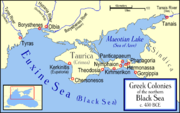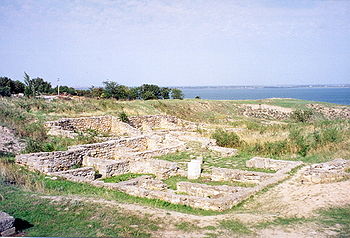
Olbia, Ukraine
Encyclopedia

Miletus
Miletus was an ancient Greek city on the western coast of Anatolia , near the mouth of the Maeander River in ancient Caria...
on the shores of the Southern Bug
Southern Bug
The Southern Bug, also called Southern Buh), is a river located in Ukraine. The source of the river is in the west of Ukraine, in the Volyn-Podillia Upland, about 145 km from the Polish border, and flows southeasterly into the Bug Estuary through the southern steppes...
estuary (Ὕπανις, Hypanis), opposite Berezan Island
Berezan Island
Berezan is an island in the Black Sea at the entrance of the Dnieper-Bug estuary, Mykolaiv Oblast, Ukraine. The island measures approximately 900 metres in length by 320 metres in width...
. Its harbour was one of the main emporia on the Black Sea
Black Sea
The Black Sea is bounded by Europe, Anatolia and the Caucasus and is ultimately connected to the Atlantic Ocean via the Mediterranean and the Aegean seas and various straits. The Bosphorus strait connects it to the Sea of Marmara, and the strait of the Dardanelles connects that sea to the Aegean...
for the export of cereals, fish, and slaves to Greece, and for the import of Attic goods to Scythia
Scythia
In antiquity, Scythian or Scyths were terms used by the Greeks to refer to certain Iranian groups of horse-riding nomadic pastoralists who dwelt on the Pontic-Caspian steppe...
.
Layout
The triangular site of the Greek colony covers the area of fifty hectareHectare
The hectare is a metric unit of area defined as 10,000 square metres , and primarily used in the measurement of land. In 1795, when the metric system was introduced, the are was defined as being 100 square metres and the hectare was thus 100 ares or 1/100 km2...
s. The lower town (now largerly submerged by the Bug) was occupied chiefly by the dockyards and the houses of artisans. The upper town was a main residential quarter, composed of square blocks and centered on the agora
Agora
The Agora was an open "place of assembly" in ancient Greek city-states. Early in Greek history , free-born male land-owners who were citizens would gather in the Agora for military duty or to hear statements of the ruling king or council. Later, the Agora also served as a marketplace where...
with temples scattered in the vicinity. The town was ringed by a stone wall with towers.
History
The Greek colony, highly important commercially, endured for a millennium. During the 5th century BCE, when the colony was visited by HerodotusHerodotus
Herodotus was an ancient Greek historian who was born in Halicarnassus, Caria and lived in the 5th century BC . He has been called the "Father of History", and was the first historian known to collect his materials systematically, test their accuracy to a certain extent and arrange them in a...
, it minted distinctive cast bronze money
Money
Money is any object or record that is generally accepted as payment for goods and services and repayment of debts in a given country or socio-economic context. The main functions of money are distinguished as: a medium of exchange; a unit of account; a store of value; and, occasionally in the past,...
in the shape of leaping dolphins. Unusual in shape considering the round coins common in the Greek world
Ancient Greece
Ancient Greece is a civilization belonging to a period of Greek history that lasted from the Archaic period of the 8th to 6th centuries BC to the end of antiquity. Immediately following this period was the beginning of the Early Middle Ages and the Byzantine era. Included in Ancient Greece is the...
, this form of money is said to have originated from sacrificial tokens used in the Temple of Apollo
Temple of Apollo
Temple of Apollo can refer to:*Greece**Temple of Apollo, Corinth**Temple of Apollo **Temple of Apollo at Bassae**Temple of Apollo Patroos*Cyprus**Temple of Apollo Hylates, Limassol*Italy**Temple of Apollo Palatinus, in Rome...
.
Martin Litchfield West
Martin Litchfield West
Martin Litchfield West is an internationally recognised scholar in classics, classical antiquity and philology...
speculates that early Greek religion
Greek religion
Greek religion can refer to several things, including*Ancient Greek religion**Greek hero cult**Eleusinian Mysteries**Hellenistic religion**Platonic idealism*Greek Orthodox Church*Religion in Greece*Hellenic Polytheistic Reconstructionism...
, especially the Orphic Mysteries, was heavily influenced by Central Asia
Central Asia
Central Asia is a core region of the Asian continent from the Caspian Sea in the west, China in the east, Afghanistan in the south, and Russia in the north...
n shamanistic
Shamanism
Shamanism is an anthropological term referencing a range of beliefs and practices regarding communication with the spiritual world. To quote Eliade: "A first definition of this complex phenomenon, and perhaps the least hazardous, will be: shamanism = technique of ecstasy." Shamanism encompasses the...
practices. A large number of Orphic graffiti unearthed in Olbia seems to testify that the colony was one major point of contact.
After the town adopted a democratic constitution, its relations with Miletus were regulated by a treaty, which allowed both states to coordinate their operations against Alexander's general Zopyrion
Zopyrion
Zopyrion was a Macedonian general.-Zopyrion's campaign:Zopyrion was made a governor either of Thrace or of Pontus by Alexander the Great. In 331 BC he led an invasion of Scythian lands, "thinking that, if he did not attempt something, he should be stigmatized as indolent" .For this purpose he...
in the 4th century BC. By the end of the 3rd century, the town declined economically and accepted the overlordship of King Skilurus
Skilurus
Skilurus or Scylurus was the best known king of Scythia in the 2nd century BC. He was the son of a king and the father of a king, but the relation of his dynasty to the previous one is disputed...
of Scythia
Scythia
In antiquity, Scythian or Scyths were terms used by the Greeks to refer to certain Iranian groups of horse-riding nomadic pastoralists who dwelt on the Pontic-Caspian steppe...
. It flourished under Mithridates Eupator but was sacked by the Getae
Getae
The Getae was the name given by the Greeks to several Thracian tribes that occupied the regions south of the Lower Danube, in what is today northern Bulgaria, and north of the Lower Danube, in Romania...
under Burebista
Burebista
Burebista was a king of the Getae and Dacians, who unified for the first time their tribes and ruled them between 82 BC and 44 BC. He led plunder and conquest raids across Central and Southeastern Europe, subjugating most of the neighbouring tribes...
, a catastrophe which brought Olbia's economic prominence to an abrupt end.
Having lost two thirds of its settled area, Olbia was restored by the Romans, albeit on a small scale and with a large admixture of barbarian population. Dio of Prusa visited the town and described it in his Borysthenic Discourse (the town was often called Borysthenes
Borysthenes
Borysthenes is a geographical name from classical Antiquity. It usually refers to the Dnipro River, but occasionally to the Pontic Olbia, a town situated at the mouth of that river. The Borysthenes is mentioned numerous times in 'The History of the Decline and Fall of the Roman Empire' by Edward...
, after the river). The settlement, incorporated into the province of Lower Moesia
Moesia
Moesia was an ancient region and later Roman province situated in the Balkans, along the south bank of the Danube River. It included territories of modern-day Southern Serbia , Northern Republic of Macedonia, Northern Bulgaria, Romanian Dobrudja, Southern Moldova, and Budjak .-History:In ancient...
, was eventually abandoned in the 4th century AD, when it was burnt at least twice in the course of the so-called Gothic (or Scythian) wars.
Excavation

Boris Farmakovsky
Boris Farmakovsky was a Russian archaeologist, who began professional excavations of the ancient Greek colony of Olbia in Ukraine....
from 1901 to 1915 and from 1924 to 1926. As the site was never reoccupied, archaeological finds (particularly inscriptions and sculpture) proved rich. Today archaeologists are under pressure to explore the site, which is being eroded by the Black Sea
Black Sea
The Black Sea is bounded by Europe, Anatolia and the Caucasus and is ultimately connected to the Atlantic Ocean via the Mediterranean and the Aegean seas and various straits. The Bosphorus strait connects it to the Sea of Marmara, and the strait of the Dardanelles connects that sea to the Aegean...
.
Further reading
- Krapivina, Valentina; Diatroptov, Pavel. "An Inscription of Mithradates VI Eupator's Governor from Olbia", Ancient Civilizations from Scythia to Siberia, Vol. 11, Issue 3/4. (2005), pp. 167–180.
- David Braund and S.D. Kryzhitskiy (eds), Classical Olbia and the Scythian World: From the Sixth Century BC to the Second Century AD (Oxford: Oxford University Press/British Academy, 2007) (Proceedings of the British Academy, 142).
- Alexander V. Karjaka, "The Defense Wall in the Northern Part of the Lower City of Olbia Pontike," in Pia Guldager Bilde, Jane Hjarl Petersen (ed.), Meetings of Cultures in the Black Sea Region: Between Conflict and Coexistence (Aarhus, Aarhus Universitetsforlag, 2008) (Black Sea Studies, 8), 163-180.
- Alexander V. Karjaka, "The Demarcation System of the Agricultural Environment of Olbia Pontike," in Pia Guldager Bilde, Jane Hjarl Petersen (ed.), Meetings of Cultures in the Black Sea Region: Between Conflict and Coexistence (Aarhus, Aarhus Universitetsforlag, 2008) (Black Sea Studies, 8), 181-192.
External links
- Ancient Coinage of Sarmatia, Olbia
- Blog about Olvia (Olbia) and artifacts found at its site
- Pyotr Osipovich Karyshkovskij-IkarPyotr Osipovich Karyshkovskij-IkarPyotr Osipovich Karyshkovskij-Ikar - Ukrainian Soviet historian, numismatist, a scholar and lexicographer....
Coins of Olbia: Essay of Monetary Circulation of the North-western Black Sea Region in Antique Epoch. Киев, 1988. ISBN 5-12-000104-1. - Pyotr O. Karyshkovskij-Ikar(fridmanbooks.netfirms.com)

